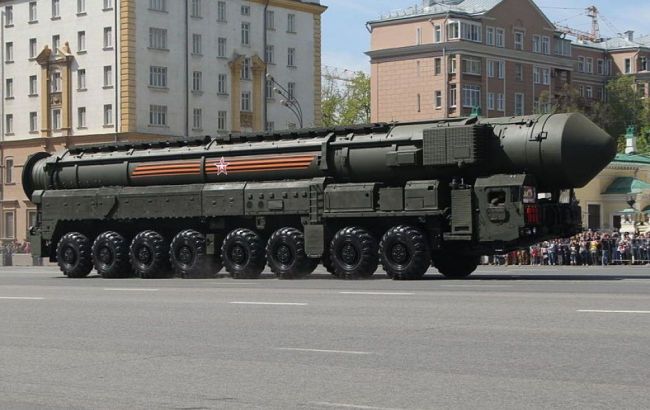Up to 12,000 km of danger: Why Russia's RS-24 Yars missile poses nuclear threat
 Illustrative photo: Intercontinental ballistic missile Yars (wikipedia.org)
Illustrative photo: Intercontinental ballistic missile Yars (wikipedia.org)
Defense Intelligence of the Ministry of Defense of Ukraine warned that on the night of May 19, Russia plans to launch an RS-24 intercontinental ballistic missile from the Yars system. This is a training and combat maneuver aimed at intimidating Ukraine and its partners.
Takeaways:
- Why was the RS-24 Yars developed?
- Is it connected to nuclear weapons?
- When was the RS-24 Yars commissioned, and why is it dangerous?
Why was the RS-24 Yars created?
The RS-24 Yars is a fifth-generation strategic missile system developed by the Moscow Institute of Thermal Technology. It was designed to replace the Topol-M system.
This weapon is intended for retaliatory strikes in the event of nuclear aggression. Its purpose is to deliver nuclear warheads over intercontinental distances. The system comes in two variants: silo-based and mobile launchers.
At its core, it uses a modernized missile from the Topol-M system equipped with multiple independently targetable warheads.
First test launch and commissioning
The first test launch took place on May 29, 2007, at the Russian Plesetsk test site's launch pad. Testing was completed by the end of 2009. That same year, the missile system was officially commissioned.
Since 2010, Yars missiles have been mass-produced and supplied to Russia's Strategic Rocket Forces.
Is there a connection to nuclear weapons?
The Yars missile system was designed as a carrier for nuclear warheads, so it has a direct link to nuclear weapons. The missile carries:
-
A multiple independently targetable reentry vehicle (MIRV) with 3 to 6 separate nuclear warheads.
-
Each warhead has a yield of about 500 kilotons, which is dozens of times more powerful than the bomb dropped on Hiroshima.
The RS-24 Yars is built to overcome missile defense systems. It can change its trajectory, and its warheads fly independently.
How many launches have there been?
Since 2007, there have been over 10 test and training-combat launches. Open sources indicate that non-nuclear training warheads are often used to demonstrate readiness.
Recent launches include:
- February 6, 2019, from the Plesetsk test site's launch pad;
- October 18, 2022, during strategic forces training;
- A planned launch on May 19, 2025, according to Ukraine's Defense Intelligence.
Why is the Russian RS-24 Yars dangerous?
The RS-24 Yars missile system presents several threats:
- Flight range between 10,000 and 12,000 kilometers, allowing it to strike targets anywhere on the planet.
- High survivability — mobile launchers can change positions and are difficult to track by satellites.
- Flight speed exceeding Mach 20 in the terminal phase.
- Ability to overcome missile defense due to decoys, complex trajectories, and hypersonic warheads.
All of this makes Yars one of the most dangerous components of Russia's nuclear triad. However, these characteristics are generally declared and may contain elements of Russian military propaganda.
Other Russian training-combat tests
On November 21, 2024, Russia launched an Oreshnik missile without nuclear warheads at the Pivdenmash factory in Dnipro. The launch occurred from the Kapustin Yar test site in Russia's Astrakhan region. This test occurred during the ongoing war against Ukraine.
The Oreshnik missile is believed to be based on the RS-26 Rubezh intercontinental ballistic missile. It has a flight range of about 800-850 kilometers and can reach speeds up to Mach 11.
This missile can carry both conventional and nuclear warheads. Its high speed makes interception difficult.
New threats from the Oreshnik missile
Ahead of May 9, Russian Telegram channels claimed that Kremlin President Vladimir Putin had allegedly ordered the targeting of Kyiv with the Oreshnik missile. The National Security and Defense Council of Ukraine dismissed this as an unsuccessful intimidation attempt.
Recently, Ukraine's Defense Intelligence chief, Kyrylo Budanov, stated that the intelligence service always warns Ukrainians if there is a threat of weapon use.
"You saw that there was no information from the Defense Intelligence of the Ministry of Defense of Ukraine (about a threat of an Oreshnik strike -ed.). Calm down. When something happens, unfortunately, you always see warnings from us," Budanov told journalists about the possible launch.

